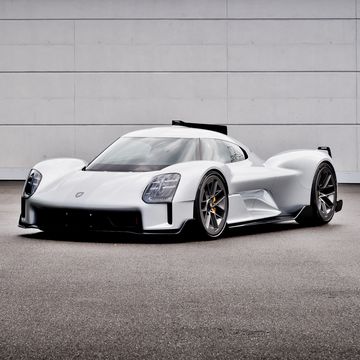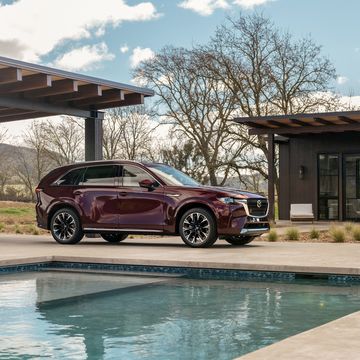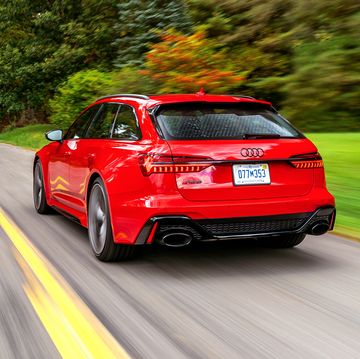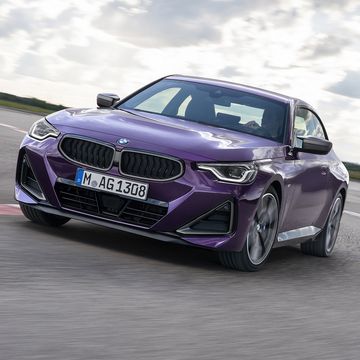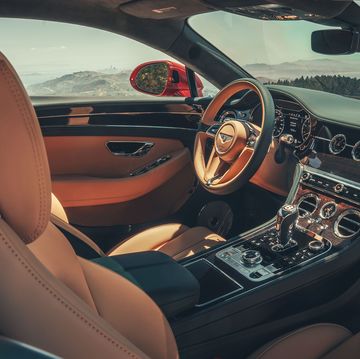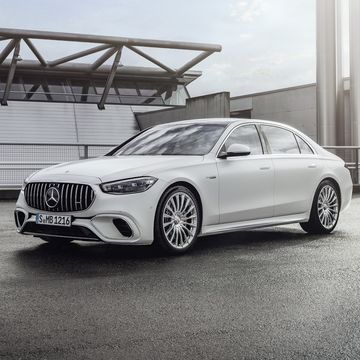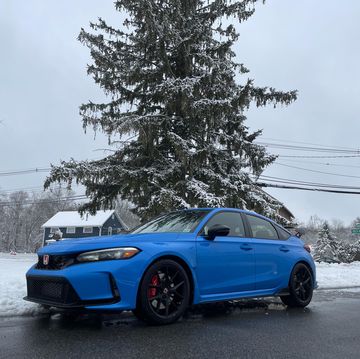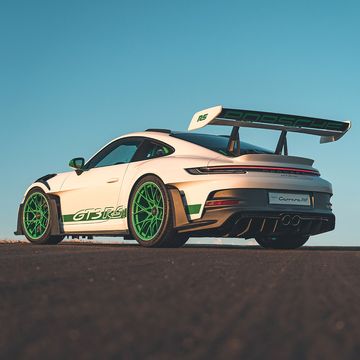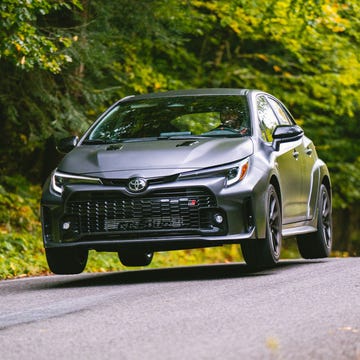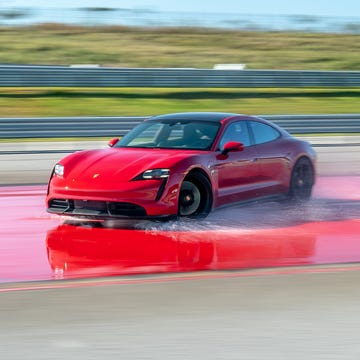Those of us pushing 40 haven't been alive long enough to witness a new American car become the envy of the world. We're seasoned enough to think that clutch pedals are mandatory equipment and touch screens are distractions, old enough to have seen car companies and friends born to fanfare and die early.
And we've been burned countless times for believing America would deliver a new car that would turn the world on its head.
We rooted for the home team, but we gave our allegiances (and down payments) to the Germans and the Japanese, wondering if the American car companies could ever make a truly amazing car. Not just a good car-America makes plenty of very good cars today, thankfully-but a true game changer, a machine so breathtaking that the whole world must stop and sigh "wow."
It has happened. For the first time since automobiles had fins, the world stands in awe of a car from the United States. We're proud to announce that Americans have crafted an automobile so advanced that no one else could have built it. It's electric, but it departs sufficiently from the poor-mouthed apologia and self-righteous marketing of previous electric cars to almost seem an epiphany. It's unique, it's from Silicon Valley, and it's called the Tesla Model S.
Tesla Motors made an EV believer out of many with its 2008 Roadster. Little more than a Lotus Elise with a battery pack and electric motor, it showed us that the silent, electron-powered future could actually work-and quickly, at that. The Roadster, however, was a more expensive, more niche variant of an already very expensive, very niche car.
The Model S benefits from the real-world knowledge Tesla gained from its first EV, but the two cars share little. The S is new from the ground up. Save a shift lever, turn-signal stalk, and window switches borrowed from the Mercedes-Benz parts bin, it shares no significant parts with any other car.
It is, however, a dead ringer dimensionally for the Audi A7, a fantastic hatchback that has captivated every staffer at this magazine with its looks, usability, and performance (see page 78). Because the Audi is both the Tesla's doppelgänger and one of the best cars currently made, the A7 is essentially the Model S's gasoline-powered benchmark, the standard it needs to beat. More on that in a moment.
The Tesla's motor is mounted directly behind the rear axles and drives them directly. The battery pack is a four-inch-high stressed structural member mounted underneath the floor. Its charge capacity and the amount of power it can deliver vary with Model S trim level. We tested a Model S Performance, which comes with the most-capable battery. The fastest Performance models allow their 85-kWh batteries to send 310 kW (416 hp) to the motor; according to Tesla, our top-of-the-range, $92,400 Model S should have accelerated to 60 mph in 4.4 seconds.
Tesla is wrong. Our car did the deed in 4.1 seconds.
That's way faster than an A7-in fact, it's within a blink of the twin-turbo V-8-powered S7, which has a launch-control system that performs a violent clutch dump. In a normal stoplight drag (i.e., no launch control), the Tesla outruns the S7.
Despite carrying around a battery that weighs more than a quarter-ton, the rear-wheel-drive Tesla also weighs only 288 pounds more than the all-wheel-drive S7, and its rear-biased weight distribution means it doesn't need trickery like torque-vectoring rear differentials to pivot in a corner. The Model S Signature and Performance models ride on height-adjustable air shocks that soak up every bump. We didn't once encounter a pavement imperfection large enough to strike the bump stops. Body motions are controlled so well we had a hard time even noticing any.
Traction control is partially defeatable, but stability control isn't-unless you take drastic moves like cutting wires or pulling fuses. We're not going to admit to either, but in the hypothetical event that we did pull a fuse to facilitate a photo, we'd be able to report that the Model S is nearly neutral at its limit and supremely easy to drift.
The Model S has three selectable levels of steering assist, and though none is perfect, the Sport mode comes commendably close to natural weighting-and for the first time, we won't complain about electric power assist being numb. After all, it would be absurdly decadent to install a gasoline tank and a small engine to run a hydraulic power-steering pump just for the sake of some steering feel.
Tesla wisely decided against a blended brake system, forgoing the cost, complexity, and miserable brake feel that plagues almost every electric or hybrid-electric vehicle on the road. Instead, fully releasing the accelerator pedal engages a user-selectable amount of regeneration. The immediate benefit of the setup is that it leaves a conventional braking system attached to the pedal; a secondary benefit is that, in normal driving, you only occasionally need to move your foot to the left pedal.
Take a moment to note that we haven't complained about anything. Car companies have been telling us for years that the science of making a car is really an art-something mere mortal engineers cannot accomplish without teams of artists, each wielding a palette of thousands of paints. Tesla just walked in with a rattle can, spray-painted a picture-perfect mural, and shut them all up. It could be that Elon Musk hired immense talent away from existing car companies, or it could be that we've reached a point in the history of the automobile where the car itself is a commodity-the engineering is a known quantity, and anyone who tries hard enough can make a good car. Both are likely true.
One thing is undeniable: Rolling down the road in any electric car, even this late in the development game, is an eerie experience. At highway speed, you don't hear appreciably less noise-modern internal combustion cars enjoy the silencing benefits of dramatically overdriven transmissions and incredibly isolated passenger compartments-but everything feels otherworldly. Part of the difference is the Model S's cartoonishly instant response to prods of the accelerator pedal. The other part is the knowledge that your vehicle doesn't have a tailpipe from which to excrete poisonous gas, even if you wanted it to.
When you're in a supercar-fast electric car like the Tesla, the driving experience is an odd cognitive mash-up-somewhere between shouting Greenpeace-approved obscenities at Toyota Priuses and dusting Corvettes from stoplights on a cruise night.
The Model S isn't perfect; no car is. But tellingly, our gripes are limited to the kinds of things that we gripe about in normal cars: The Model S's power seats don't have a memory setting. The interior rattles occasionally over very rough pavement. The slow, rain-sensing automatic wipers seem to vary their speed with no correlation to how much rain is hitting the windshield. The sheer normality of these complaints-not an alternative-powerplant quibble among them-is the amazing thing here.
What remains is startup stuff, the kind of small misses that arise if you've never built a car before. If you're standing behind the Tesla looking at the back of its thin, split-folding rear seats, for example, the piping isn't quite straight. Oh, and there's no center armrest back there. The huge panoramic
sunroof can only be opened or closed via a submenu on the touch screen; we would much prefer a button.
The headlights (and, in particular, high beams) are weak. The raked rear window could use a wiper. There's not a single interior storage binnacle. There's no cargo cover for the trunk. The Model S has no ignition switch-the car turns on and is ready to go when you sit in the driver's seat and hit the brake pedal-and that means you can't easily turn it off when, say, you're sitting in the car waiting for someone and don't want the climate control or radio on.
Unsurprisingly, the enormous 17-inch touch screen in the center console is the Tesla's centerpiece. It's gorgeous and works well. The Google Maps Navigation display is huge and breathtakingly high-resolution, but it presents street names in a font so small you'd need an electron microscope to read
them. All of this can be fixed with software updates. The basic hardware-the capacitive touch screen-is brilliant: clear, bright, and as responsive as an Apple iPad, replete with pinch-to-zoom gestures.
Fact is, we seriously dislike only one thing about the Tesla Model S: its exterior door handles. They look like chrome towel bars in a chic hotel bathroom, and they electrically retract fully for better aerodynamic performance, but they annoyed us to no end. Not only do the handles extend slowly (or not at all) when you walk up and press them, but the computer then requires a split second to unlatch the doors after you pull on the handle. Invariably, this makes you look like a would-be car thief who took one too many muscle relaxants. And given the Model S's ability to attract crowds, it's all the more embarrassing. There is a special place in hell reserved for the engineer of those door handles.
But there's a special place in the automotive world reserved for the Model S. It represents not only the point where the American car industry returns to the foreground but also that pivotal moment when electric vehicles morph from a niche-market curiosity to a viable alternative to a conventional
car.
Think of what that phrase implies. The Tesla Model S is the first electricity-powered car that genuinely competes with a similar gasoline-powered car: in speed, in everyday usability, and especially in price. Every electric vehicle on our roads today-Tesla's own Roadster included-escaped from a dealership with a sticker price twice that of an identical car with an internal combustion engine. (Don't think so? Go compare a Nissan Leaf with a Nissan Versa, which costs half as much. Or hit your local Ford dealer and take a good look at both the Focus and Focus Electric.)
In contrast, the Tesla Model S competes on price with an Audi A7 or S7. It'd be impressive enough if those Audis were econoboxes, but they're not. They're among the finest cars in the world. And yet Tesla, on its first shot with barely a dress rehearsal, has built a car genuinely competitive with the best. That's something that has proved impossible over and over again with conventional gasoline powertrains delivered by giants like Acura, Lexus, and Infiniti. Not to mention Lincoln, Cadillac, and Maserati, or the many other brands like Saab or Sterling that died trying.
The next time you're scared of what the automotive future holds, frightened by visions of slothlike Toyota Priuses and range-anxiety-provoking Nissan Leafs, take comfort in the fact that the Model S exists. A future packed with Teslas would be the quickest, quietest world you've ever imagined.
Set aside the discussion as to whether EVs are actually feasible given our overtaxed power grid, and whether our electricity-generating power plants are any more environmentally friendly than a really efficient gasoline engine. Ignore, for a moment, that we don't know how the Model S will age or how reliable it will be a decade on. Time will answer all of these, as well as the question of whether Tesla itself can stay solvent long enough to survive into maturity. We set them aside with the knowledge that the Tesla S means these discussions will finally be worth having. The Model S is the car that proves that the EV isn't just viable, but truly desirable.
Beautiful, well-crafted, cool, and seriously fast, the Model S isn't just the most important car of the year. It's the most important car America has made in an entire lifetime.



